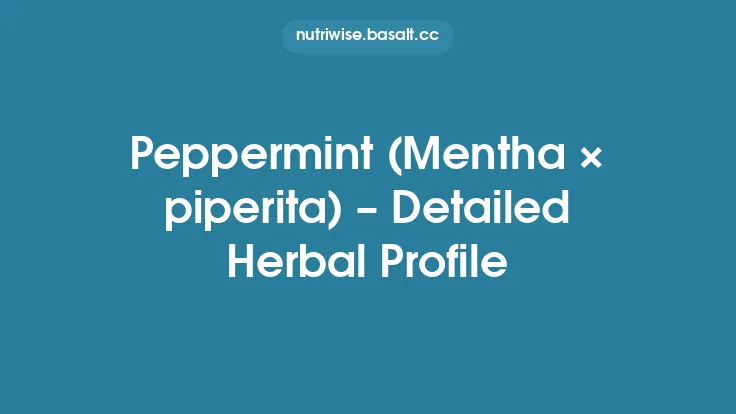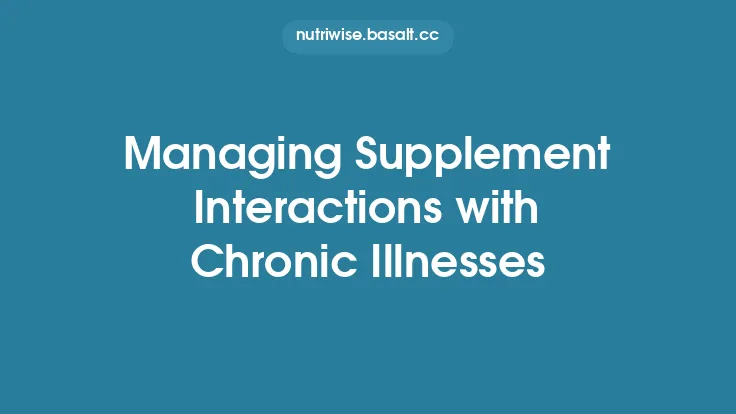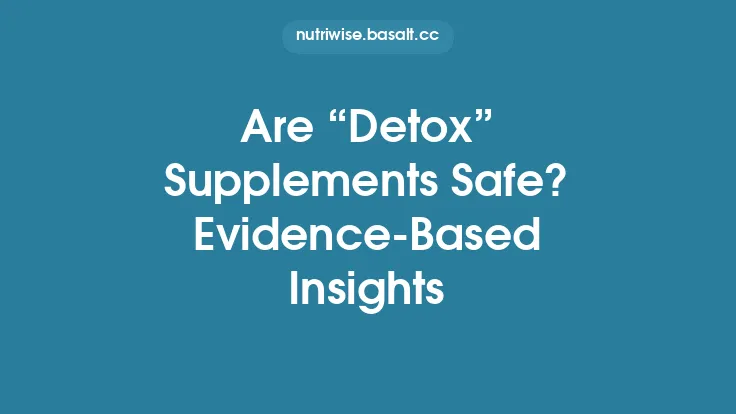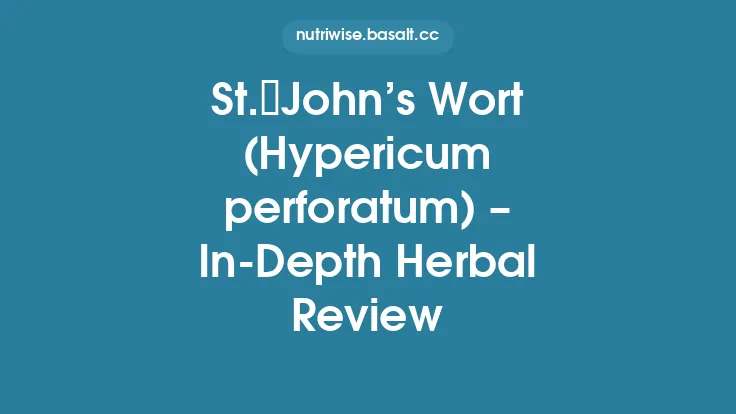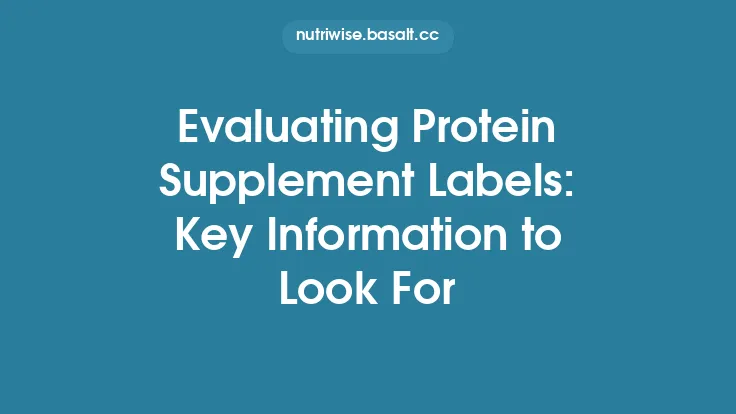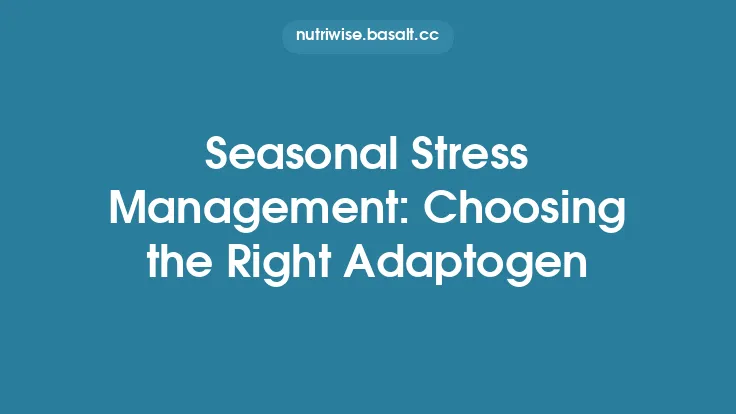Milk thistle (Silybum marianum) is a hardy, thistle‑like plant native to the Mediterranean basin that has been cultivated for centuries for its medicinal properties, particularly its reputed hepatoprotective effects. The plant’s striking purple‑blue flower heads and spiny, white‑veined leaves make it easily recognizable in gardens and wild fields alike. Modern herbal supplement manufacturers harvest the seeds and, more importantly, the seed‑coat (also called the pericarp) to produce extracts rich in a group of flavonolignans collectively known as silymarin. This profile delves into the botanical characteristics, phytochemistry, mechanisms of action, clinical evidence, safety considerations, and practical usage guidelines for milk thistle as a dietary supplement.
Botanical Description
- Family: Asteraceae (Compositae)
- Genus & Species: *Silybum marianum* (L.) Gaertn.
- Growth habit: Biennial or short‑lived perennial herb, reaching 1.5–2 m in height.
- Root system: Taproot with a shallow, fibrous lateral network, enabling the plant to thrive in well‑drained, slightly alkaline soils.
- Leaves: Large, lobed, and covered with a dense indumentum of white, woolly hairs on the underside; the upper surface bears a characteristic white, crescent‑shaped vein.
- Inflorescence: Capitula (flower heads) are 3–5 cm in diameter, with purple‑blue ray florets surrounding a central disc of yellow florets.
- Fruit: Achenes (small, dry, one‑seeded fruits) are encased in a hard, glossy seed‑coat that contains the bulk of the plant’s bioactive constituents.
The seed‑coat is harvested after the plant matures and the achenes turn brown. The pericarp is then dried, milled, and subjected to solvent extraction (commonly ethanol, methanol, or a mixture of water and alcohol) to yield standardized silymarin extracts.
Historical and Traditional Use
Records of milk thistle’s medicinal use date back to ancient Egypt, where it was listed among the “23 herbs of immortality” in the Ebers Papyrus (c. 1550 BCE). Classical Greek physicians, including Dioscorides, described its use for “liver ailments” and “bile disorders.” In medieval Europe, monastic herbalists employed milk thistle as a tonic for jaundice and as a protective agent against poisoning.
Traditional applications can be grouped into three broad categories:
- Hepatoprotection: Treatment of liver congestion, jaundice, and hepatitis.
- Gallbladder support: Promotion of bile flow and alleviation of biliary colic.
- General tonic: Use as a mild diuretic and anti‑inflammatory agent for skin conditions and digestive disturbances.
These ethnobotanical practices laid the groundwork for modern scientific inquiry into the plant’s hepatoprotective potential.
Phytochemistry
The pharmacologically active fraction of milk thistle is the silymarin complex, a mixture of flavonolignans that accounts for 70–80 % of the seed‑coat’s dry weight. The principal constituents are:
| Compound | Approx. % of Silymarin | Structural Class |
|---|---|---|
| Silybin (also called silibinin) | 30–45 % | Flavonolignan (a dimer of taxifolin and coniferyl alcohol) |
| Silydianin | 15–20 % | Flavonolignan |
| Silychristin | 10–15 % | Flavonolignan |
| Isosilybin A/B | 5–10 % | Flavonolignan (diastereomers) |
| Taxifolin (a flavonoid) | 5–10 % | Flavonoid |
| Other minor flavonolignans & phenolic acids | <5 % | Various |
In addition to silymarin, the seed‑coat contains fatty acids (linoleic, oleic, palmitic), phytosterols (β‑sitosterol), tocopherols (vitamin E), and trace amounts of alkaloids. The high antioxidant capacity of silymarin is attributed to its phenolic hydroxyl groups, which can donate electrons and scavenge free radicals.
Standardized commercial extracts are typically labeled as containing 80 % silymarin (by weight), with some formulations further specifying a minimum of 70 % silybin for enhanced potency.
Mechanisms of Action
1. Antioxidant Activity
- Free‑radical scavenging: Silymarin neutralizes superoxide anion (O₂⁻), hydroxyl radical (·OH), and peroxyl radicals (ROO·) through direct electron donation.
- Lipid peroxidation inhibition: By stabilizing cell‑membrane phospholipids, silymarin reduces malondialdehyde (MDA) formation, a marker of oxidative damage.
2. Membrane Stabilization
- Protein synthesis up‑regulation: Silymarin stimulates ribosomal RNA polymerase, enhancing the synthesis of structural proteins that reinforce hepatocyte membranes.
- Inhibition of toxin entry: The flavonolignans block the influx of hepatotoxic substances (e.g., carbon tetrachloride, aflatoxin B₁) by modulating membrane transporters.
3. Anti‑Inflammatory Effects
- NF‑κB pathway modulation: Silymarin suppresses nuclear factor‑kappa B activation, decreasing transcription of pro‑inflammatory cytokines (TNF‑α, IL‑1β, IL‑6).
- Cyclooxygenase (COX) inhibition: Mild COX‑2 inhibition contributes to reduced prostaglandin synthesis in inflamed hepatic tissue.
4. Antifibrotic Action
- Inhibition of hepatic stellate cell (HSC) activation: Silymarin interferes with transforming growth factor‑β1 (TGF‑β1) signaling, curbing collagen deposition and fibrosis progression.
- Matrix metalloproteinase (MMP) regulation: It promotes MMP‑1 activity while down‑regulating tissue inhibitor of metalloproteinases (TIMP‑1), facilitating extracellular matrix remodeling.
5. Modulation of Drug Metabolizing Enzymes
- Cytochrome P450 (CYP) interaction: Silymarin exhibits weak inhibition of CYP3A4, CYP2C9, and CYP2D6, which can affect the pharmacokinetics of co‑administered drugs.
- Phase II conjugation enhancement: Up‑regulation of glutathione‑S‑transferase (GST) and UDP‑glucuronosyltransferase (UGT) enzymes supports detoxification pathways.
Collectively, these mechanisms underpin the clinical interest in milk thistle for liver health, metabolic regulation, and protection against oxidative stress.
Clinical Evidence and Therapeutic Applications
1. Liver Disease
- Alcoholic liver disease (ALD): Randomized controlled trials (RCTs) have shown modest improvements in serum alanine aminotransferase (ALT) and aspartate aminotransferase (AST) levels after 12–24 weeks of 420 mg silymarin taken three times daily. Meta‑analyses suggest a trend toward reduced progression of fibrosis, though heterogeneity among studies limits definitive conclusions.
- Non‑alcoholic fatty liver disease (NAFLD): Several double‑blind RCTs report decreased hepatic steatosis scores (via ultrasound or MRI‑PDFF) and improved insulin sensitivity when silymarin (140–210 mg, 2–3 times daily) is combined with lifestyle interventions.
- Viral hepatitis (HBV/HCV): Evidence is mixed; some trials indicate reduced viral load and liver enzyme normalization, while others show no significant effect. Silymarin is generally considered an adjunct rather than a primary antiviral agent.
- Drug‑induced liver injury (DILI): Case series and small trials suggest that silymarin may accelerate recovery from acetaminophen or anti‑tubercular drug toxicity, likely via its antioxidant and membrane‑stabilizing actions.
2. Metabolic and Cardiovascular Health
- Insulin resistance: A 6‑month RCT in patients with type 2 diabetes demonstrated a modest reduction in fasting glucose (≈5 mg/dL) and HbA₁c (≈0.3 %) with 210 mg silymarin taken twice daily, possibly mediated by improved hepatic insulin signaling.
- Hyperlipidemia: Some studies report reductions in total cholesterol and LDL‑cholesterol after 12 weeks of silymarin supplementation, though results are not uniformly replicated.
3. Dermatology
- Photoprotection: Topical formulations containing silymarin have shown decreased erythema and DNA damage after UV‑B exposure in human skin models, attributed to its free‑radical scavenging capacity.
- Psoriasis and eczema: Limited pilot studies suggest symptomatic relief when silymarin is used as an oral adjunct, but larger trials are needed.
4. Oncology Support
- Chemoprotective adjunct: In vitro and animal models indicate that silymarin can mitigate chemotherapy‑induced hepatotoxicity (e.g., from doxorubicin, cisplatin) without compromising anticancer efficacy. Clinical data remain preliminary.
Overall, the strongest and most consistent evidence supports milk thistle’s role in supporting liver function and ameliorating oxidative stress. Its utility in other domains is promising but requires further high‑quality research.
Dosage Forms and Recommended Intake
| Form | Typical Standardized Content | Common Daily Dose* |
|---|---|---|
| Standardized powder (capsules/tablets) | 80 % silymarin (≈70 % silybin) | 210–420 mg, divided 2–3 times daily |
| Liquid tincture (alcoholic) | 1 % silymarin (10 mg/mL) | 10–30 mL per day |
| Softgel (oil‑based) | 70 % silymarin in olive oil | 300–600 mg per day |
| Topical cream/gel | 1–2 % silymarin | Apply 2–3 times daily to affected skin |
| Food‑grade seed‑coat powder | Non‑standardized, ~30 % silymarin | 1–2 g per day (often in smoothies) |
\*Doses are based on the range used in most clinical trials and may be adjusted for specific indications, body weight, or physician recommendation. For acute liver injury, higher loading doses (e.g., 1 g three times daily) have been employed under medical supervision.
Safety, Contraindications, and Drug Interactions
General Safety Profile
- Adverse events: Milk thistle is generally well tolerated. Reported side effects are mild and include gastrointestinal upset (bloating, nausea), headache, and rare allergic skin reactions.
- Pregnancy & lactation: Human data are limited. Most authorities advise caution; the herb is classified as Category C (risk cannot be ruled out). Pregnant or nursing women should consult a healthcare professional before use.
Contraindications
- Known hypersensitivity to Asteraceae family plants (e.g., ragweed, daisies) may predispose to allergic reactions.
- Severe estrogen‑dependent conditions (e.g., estrogen‑sensitive breast cancer) – silymarin exhibits weak estrogenic activity in vitro; clinical relevance is uncertain but warrants caution.
Drug Interactions
| Drug Class | Interaction Mechanism | Clinical Significance |
|---|---|---|
| Anticoagulants/Antiplatelets (warfarin, clopidogrel) | Potential additive antiplatelet effect | Monitor INR or bleeding risk |
| Cytochrome P450 substrates (statins, certain antihistamines, benzodiazepines) | Mild inhibition of CYP3A4, CYP2C9 | May increase plasma levels; dose adjustment may be needed |
| Chemotherapeutic agents (doxorubicin, cyclophosphamide) | Hepatoprotective effect may reduce toxicity | Generally considered beneficial, but oncologist oversight required |
| Diabetes medications (insulin, sulfonylureas) | Enhanced insulin sensitivity | Monitor blood glucose to avoid hypoglycemia |
Patients on chronic medication regimens should disclose milk thistle use to their prescriber, especially when high‑dose or concentrated extracts are employed.
Quality Assurance and Standardization
- Raw Material Verification
- Botanical authentication via macroscopic and microscopic examination (leaf venation pattern, seed‑coat morphology).
- DNA barcoding (e.g., rbcL, matK regions) to confirm species identity and detect adulterants.
- Extraction Standards
- Solvent selection: Ethanol‑water mixtures (70 % ethanol) are preferred for optimal silymarin yield while minimizing residual solvent.
- Temperature control: Extraction at 40–60 °C preserves thermolabile flavonolignans.
- Standardization Metrics
- Total silymarin content (≥ 80 % w/w) measured by high‑performance liquid chromatography (HPLC) with photodiode‑array detection.
- Silybin isomer ratio (A:B) reported for consistency across batches.
- Contaminant Testing
- Heavy metals (lead, cadmium, arsenic, mercury) – limits set by USP <231> or EFSA guidelines.
- Microbial limits – total aerobic count, yeast/mold, and absence of pathogens (E. coli, Salmonella).
- Mycotoxins – aflatoxin B₁, ochratoxin A screened via LC‑MS/MS.
- Stability Assessment
- Shelf‑life studies under accelerated conditions (40 °C/75 % RH) to ensure silymarin content remains within ± 5 % of label claim for at least 24 months.
Manufacturers adhering to Good Manufacturing Practices (GMP) and third‑party certifications (e.g., NSF, USP Verified) provide the most reliable products.
Cultivation and Sustainable Harvesting
- Climate requirements: Full sun, moderate rainfall (500–800 mm annually), and well‑drained loamy soils with pH 6.5–8.0.
- Propagation: Seeds are sown in early spring; germination rates improve after a brief cold stratification (4 °C for 2–4 weeks).
- Crop rotation: Rotating with legumes or cereals reduces soil‑borne pathogens and maintains soil fertility.
- Harvest timing: Seed‑coat is collected when achenes reach full maturity (typically late summer to early autumn). Prompt drying (≤ 40 °C) preserves silymarin integrity.
- Sustainability practices: Wild‑harvested populations are monitored to prevent over‑exploitation. Certified organic farms employ integrated pest management (IPM) to minimize pesticide residues.
Regulatory Status and Legal Considerations
- United States: Milk thistle is classified as a dietary supplement under the Dietary Supplement Health and Education Act (DSHEA) of 1994. Manufacturers may make structure‑function claims (e.g., “supports liver health”) but cannot claim disease treatment without FDA approval.
- European Union: Regulated as a food supplement under the Food Supplements Directive (2002/46/EC). Health claims must be authorized by the European Food Safety Authority (EFSA); the approved claim is limited to “contributes to the normal function of the liver.”
- Canada: Listed under Natural Health Products (NHP) with a Natural Product Number (NPN). Permitted indications include “supports liver function” and “protects liver cells.”
- Australia: Categorized as a listed medicine (AUST L) for “liver support.” Products must meet the Therapeutic Goods Administration (TGA) standards for quality and labeling.
Regulatory frameworks emphasize product safety, accurate labeling, and evidence‑based claims. Consumers should look for batch numbers, expiration dates, and clear statements of silymarin content.
Future Directions and Research Gaps
- High‑Quality, Large‑Scale RCTs: Many existing trials are limited by small sample sizes, heterogeneous dosing, and short follow‑up periods. Well‑designed, multicenter studies are needed to confirm efficacy in NAFLD, viral hepatitis, and metabolic syndrome.
- Pharmacogenomics: Investigating how genetic polymorphisms in CYP enzymes or transporters affect silymarin metabolism could personalize dosing and minimize interaction risk.
- Nanotechnology Delivery Systems: Liposomal, solid‑lipid nanoparticle, and polymeric micelle formulations aim to improve oral bioavailability (currently low, ~20–30 %). Early animal data are promising, but human safety data are pending.
- Synergistic Formulations: Combining silymarin with other hepatoprotective botanicals (e.g., artichoke leaf, dandelion root) or nutraceuticals (e.g., N‑acetylcysteine) may yield additive benefits; systematic evaluation is required.
- Long‑Term Safety Surveillance: Post‑marketing registries could capture rare adverse events, especially in populations using high‑dose or multi‑herb regimens.
Addressing these gaps will refine clinical guidelines and expand the therapeutic scope of milk thistle.
Practical Guidance for Consumers
- Choose a reputable brand that provides a Certificate of Analysis (CoA) confirming ≥ 80 % silymarin and compliance with heavy‑metal limits.
- Start with a low dose (e.g., 140 mg twice daily) and monitor how your body responds, especially if you have a sensitive stomach.
- Take with meals to improve absorption; fat‑containing foods can modestly increase bioavailability.
- Track liver function tests (ALT, AST, GGT) if you are using milk thistle for liver support; discuss results with your healthcare provider.
- Avoid self‑medicating if you are on anticoagulants, chemotherapy, or hormone‑sensitive medications without professional guidance.
- Store in a cool, dry place away from direct sunlight to preserve potency; most extracts remain stable for 2–3 years when unopened.
By integrating these evidence‑based practices, individuals can responsibly incorporate milk thistle into a broader health‑maintenance regimen.
